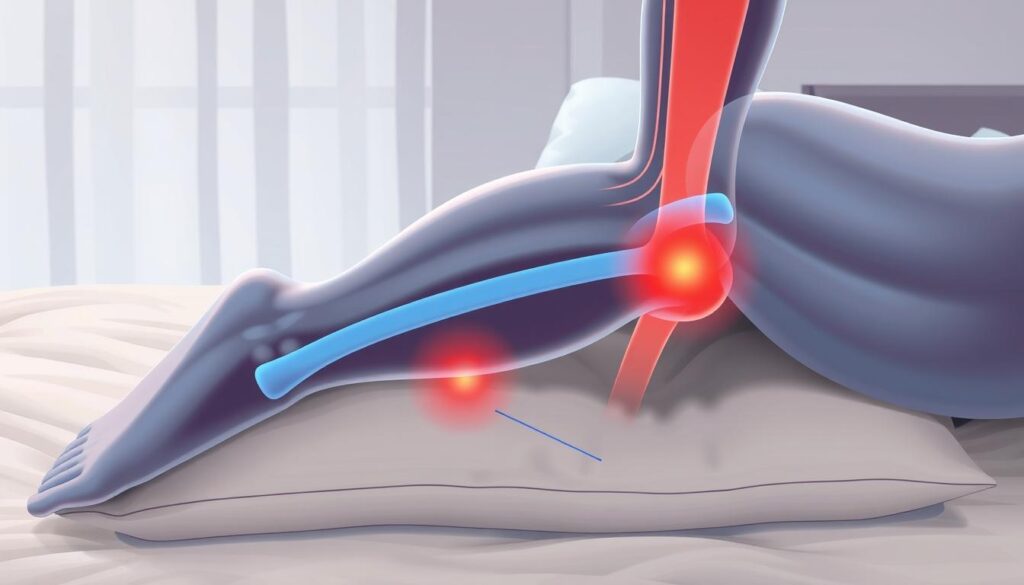If you are in pursuit of the best sleeping position for IT band pain, selecting the right sleeping position can make a big difference. This guide will help you find the best way to sleep for IT band pain relief. You’ll learn about the IT band, its symptoms, and how good sleep helps in recovery.
Key Takeaways
- Understanding IT band pain is essential for effective relief.
- The right sleeping position can help manage discomfort.
- Proper sleep positively impacts muscle recovery.
- Supportive pillows can enhance sleep quality.
- Establishing healthy sleep habits is key to long-term relief.
Understanding IT Band Pain
Understanding IT band pain is key for those with thigh or knee discomfort. The iliotibial band, or IT band, is a key stabilizer for the knee. It connects the hip to the knee, aiding in smooth movement during exercise.
What is the IT Band?
The IT band is a thick band of fascia, mainly made of connective tissue. It helps keep the knee stable and mobile. It’s vital for activities like running, cycling, and other exercises that involve leg motion.
Common Causes of IT Band Pain
Several factors can lead to IT band pain, causing discomfort. Common causes include:
- Overuse during physical activities such as running or cycling
- Tight muscles, mainly in the hips and quadriceps
- Improper footwear that fails to provide adequate support
- Uneven surfaces that increase strain on the IT band
- Muscle imbalances from inadequate stretching or strengthening
Knowing these causes can help prevent more irritation and manage IT band discomfort better.
|
Cause |
Description |
|
Overuse |
Repetitive actions in sports or exercise |
|
Tight Muscles |
Insufficient flexibility leading to strain |
|
Improper Footwear |
Shoes that do not provide necessary support |
|
Uneven Surfaces |
Increased stress on the IT band during activity |
|
Muscle Imbalances |
Weakness or tightness in certain muscle groups |
Signs You May Have IT Band Pain
Knowing the signs of IT band pain is key to managing it well. Several symptoms can show you have this condition. These symptoms can affect your physical activities and daily life.
Symptoms to Look For
Common symptoms of IT band pain include:
- Lateral knee pain, often felt during movement or physical activity
- Swelling around the knee joint
- Tenderness along the outer thigh
- A popping or snapping sensation while bending the knee
When to Seek Medical Advice
It’s important to seek medical advice IT band pain if you feel persistent discomfort. You should see a healthcare professional if:
- The pain doesn’t get better with usual self-care methods
- The pain gets worse over time
- Swelling or big mobility issues happen
An illustration depicting a side view of a human leg highlighting the iliotibial band, with emphasis on areas of discomfort, showing subtle signs like redness or inflammation. Include a background of a peaceful bedroom setting to suggest the context of sleep. The leg is resting on a soft pillow, with a slightly bent knee, and an anatomical approach showcasing the muscles and tendons around the IT band area.
Spotting these signs and symptoms helps you take action early. Quick action can stop the condition from getting worse. It also helps you get back to your daily activities more easily.
The Importance of Sleep for Recovery
Understanding how sleep impacts recovery is key for those with IT band pain. Sleep is more than just rest; it’s a time for the body to heal. It helps repair muscles, release growth hormones, and control inflammation. The quality of sleep greatly affects how well you recover.
How Sleep Affects Muscle Recovery
During sleep, the body fixes itself and helps muscles recover. Growth hormone, which helps grow and repair muscles, is released most during deep sleep. Not getting enough sleep can slow down muscle repair, leading to longer soreness and slower recovery.
People looking to recover muscles fast should focus on getting enough sleep. Aim for the recommended hours of restful sleep each night.
The Connection Between Rest and Pain Relief
A well-rested body means better pain relief. Quality sleep improves overall well-being. It also helps manage stress and emotions, which can worsen pain.
Good sleep habits can reduce pain, making daily life more comfortable. This leads to better performance in daily activities.
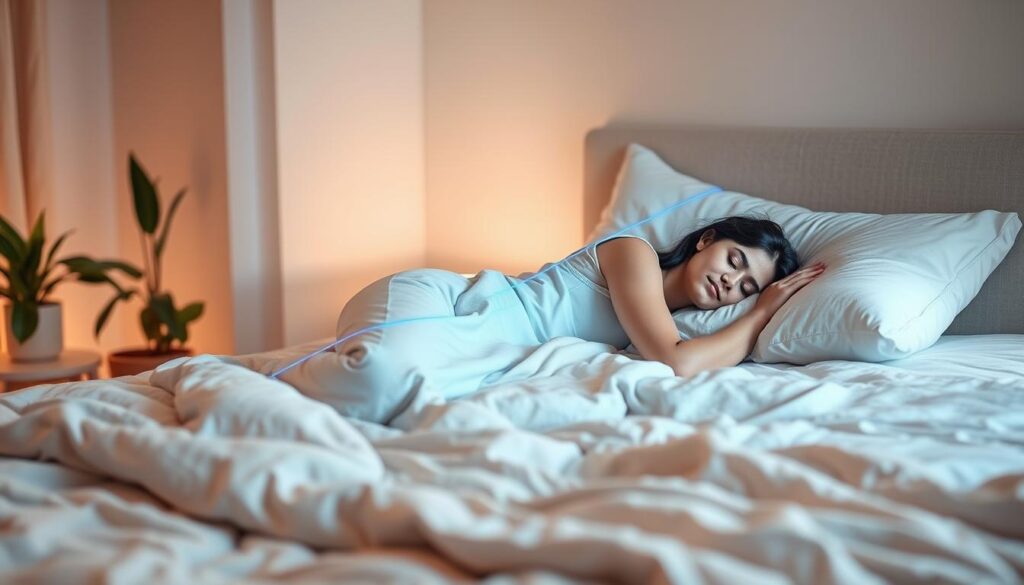
Best Sleeping Position for IT Band Pain
Choosing the right sleeping position can greatly improve comfort for those with IT band pain. Knowing the good and bad of each position helps find the best one for IT band pain.
Side Sleeping: Pros and Cons
Side sleeping is often seen as the best for IT band pain. It helps keep the spine aligned and reduces pressure on the affected area. Some benefits include:
- Reduces stress on the IT band.
- Helps maintain a natural curve of the spine.
- Facilitates easier breathing.
But, side sleeping might cause discomfort in the shoulders or hips for some. So, a good mattress and pillow are key.
Back Sleeping: A Comfortable Option
Back sleeping is another good choice for IT band pain. It supports the spine and spreads out body weight evenly. It allows for:
- Minimal strain on the back and joints.
- Easy adjustments with supportive pillows.
- Encouragement of spinal alignment.
To get more comfort, try a pillow under your knees for extra support and relief.
Avoiding Stomach Sleeping
Stomach sleeping is not recommended for IT band pain. It can put too much strain on the spine and worsen pain. Issues include:
- Risk of spinal misalignment.
- Increased pressure on the neck and back.
- Potential aggravation of existing pain.
By avoiding stomach sleeping, you can lower the chance of making your pain worse.
Additional Techniques for IT Band Relief During Sleep
Looking for ways to ease IT band pain can make your sleep better. Using pillows and stretching before bed can help. These methods reduce pressure and help your muscles heal.
Using Pillows for Support
Using pillows in the right way can help your IT band during sleep. Here are some tips:
- Knee Pillow: A pillow between your knees when sleeping on your side keeps your hips aligned. This reduces IT band stress.
- Hip Support: A small wedge pillow under your hips helps back sleepers keep their spine straight.
- Side Sleeping: Use a firm pillow under your head to support your neck. This helps your spine and lessens IT band pressure.
Implementing Stretching Routines Before Bed
Adding simple stretches to your bedtime routine can improve flexibility and reduce muscle tension. Here are some stretches to try:
- IT Band Stretch: Stand with your right leg behind your left. Lean to the left to stretch your outer thigh. Hold for 15-30 seconds and switch sides.
- Quadriceps Stretch: Stand on one leg and pull your other foot towards your glutes. Hold for 15-30 seconds on each side.
- Seated Forward Bend: Sit with your legs extended and reach forward towards your toes. Stretch your hamstrings for 15-30 seconds.
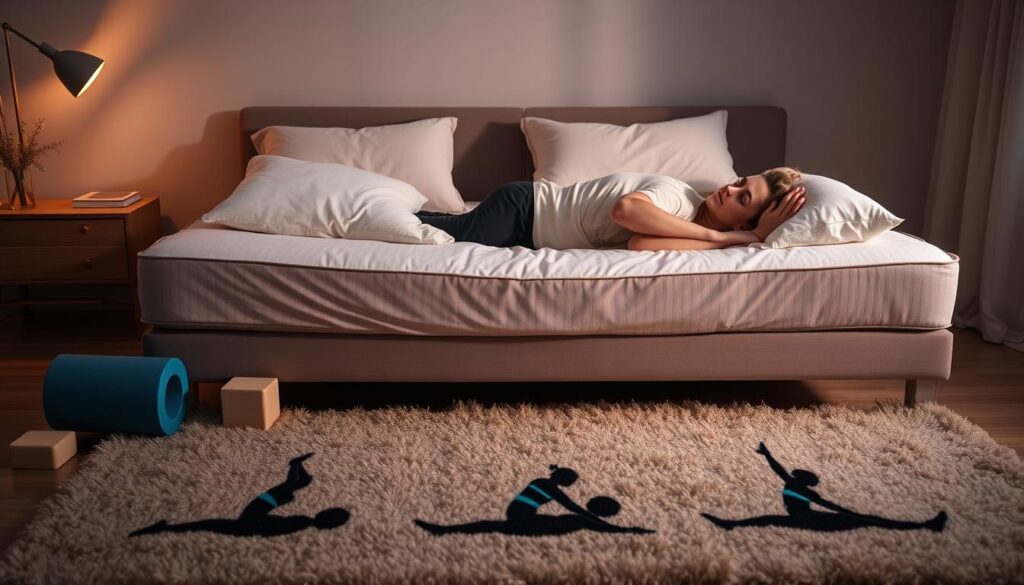
How to Set Up Your Sleep Environment
Creating a sleep environment that promotes restful sleep can help with IT band pain. Your bedroom’s components, like the mattress and pillow, are key. Designing a sleep-friendly atmosphere is vital for recovery.
Choosing the Right Mattress and Pillow
Your mattress choice affects your comfort during sleep. A supportive mattress that fits your sleep position reduces body strain, including IT band pain. Medium-firm mattresses often offer the best balance of support and comfort.
Choosing the right pillow is also important. It helps keep your neck and spine aligned. There are many types, like memory foam, latex, or adjustable pillows, to find the perfect firmness for you.
Creating a Sleep-Friendly Atmosphere
To make your bedroom sleep-friendly, consider a few factors. Keep noise levels low to avoid nighttime disturbances. A cooler room temperature also helps with sleep.
Blackout curtains can block out unwanted light, making your room darker and more restful. Calming colors and less clutter can also make your sleep environment more soothing.
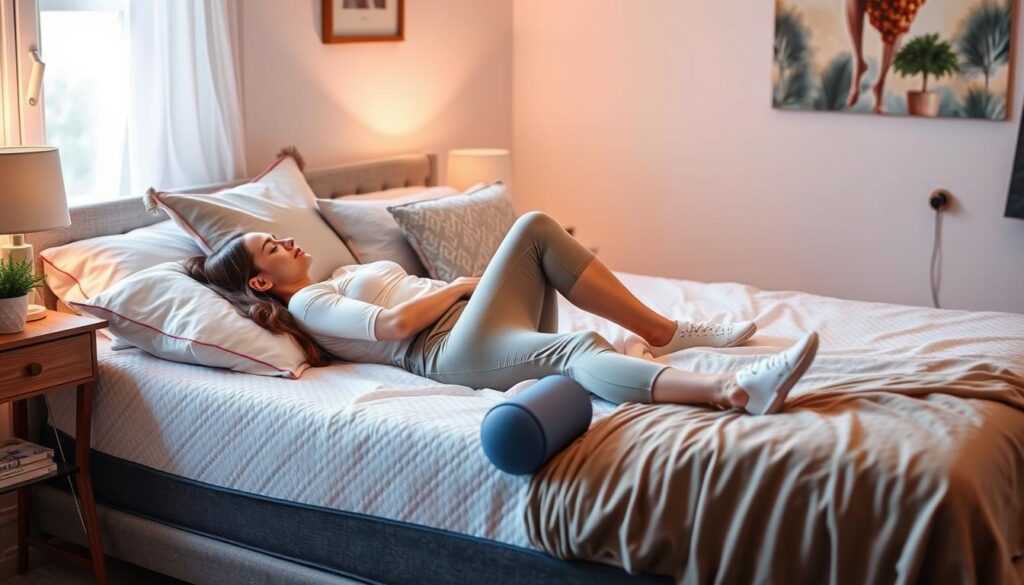
Alternative Remedies for IT Band Pain Relief
Looking for ways to ease IT band pain? There are many alternative remedies that can help. Simple methods like using warm compresses and ice packs can make a big difference. They help reduce pain and speed up healing.
Warm Compresses and Ice Packs
Warm compresses relax tight muscles, which is key for IT band pain relief. The warmth boosts blood flow, helping muscles recover. On the other hand, ice packs cut down on swelling and dull sharp pains. Switching between heat and ice can offer the best results. Here’s a simple routine to try:
|
Method |
Application Time |
Effects |
|
Warm Compress |
15-20 minutes |
Relaxes muscles, improves circulation |
|
Ice Pack |
15-20 minutes |
Reduces swelling, numbs pain |
Over-the-Counter Pain Relievers
If your pain doesn’t go away, over-the-counter pain relievers like ibuprofen or acetaminophen can help. These drugs manage pain and swelling well. Always stick to the dosage and talk to a doctor, though, if you’re on other meds or have health issues.
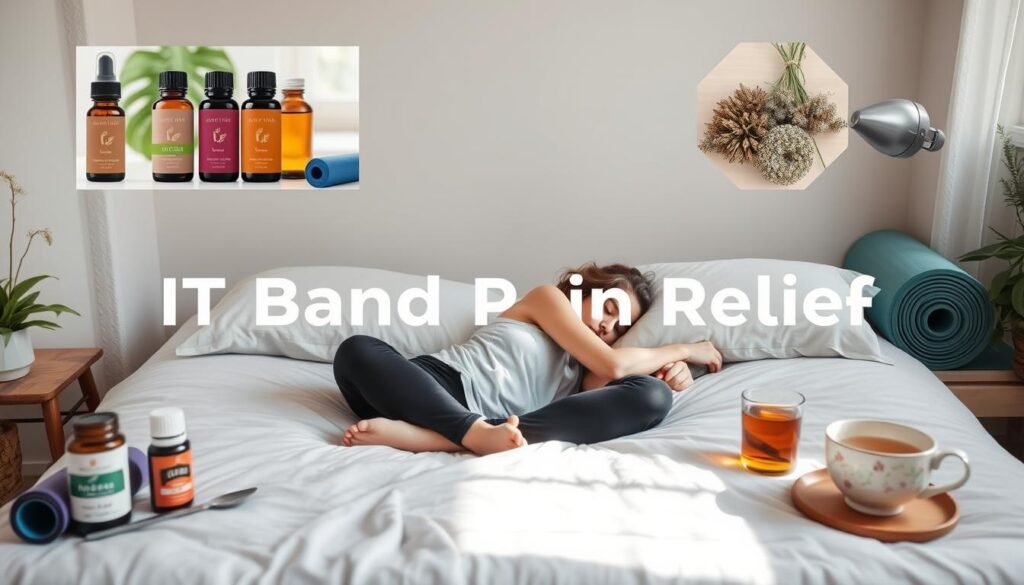
Helpful Sleep Aids for IT Band Pain Management
Managing IT band pain can be tough, making it hard to sleep well. There are sleep aids that can help improve sleep and aid in recovery. We’ll look at natural sleep aids and why it’s key to talk to a healthcare professional before using them.
Natural Sleep Aids
Natural sleep aids can offer a lot of relief for those with IT band pain. Melatonin, valerian root, and chamomile are popular choices. They are liked for their gentle effects compared to medicines.
- Melatonin: A hormone that regulates sleep-wake cycles.
- Valerian Root: An herbal supplement known for its calming effects.
- Chamomile: Often consumed as tea, chamomile can promote relaxation.
Consulting with a Healthcare Professional
It’s vital to talk to a healthcare professional before using sleep aids. Your health and medicines can impact which sleep aids are right for you. A healthcare professional can guide you on the best ways to manage IT band pain and improve sleep.
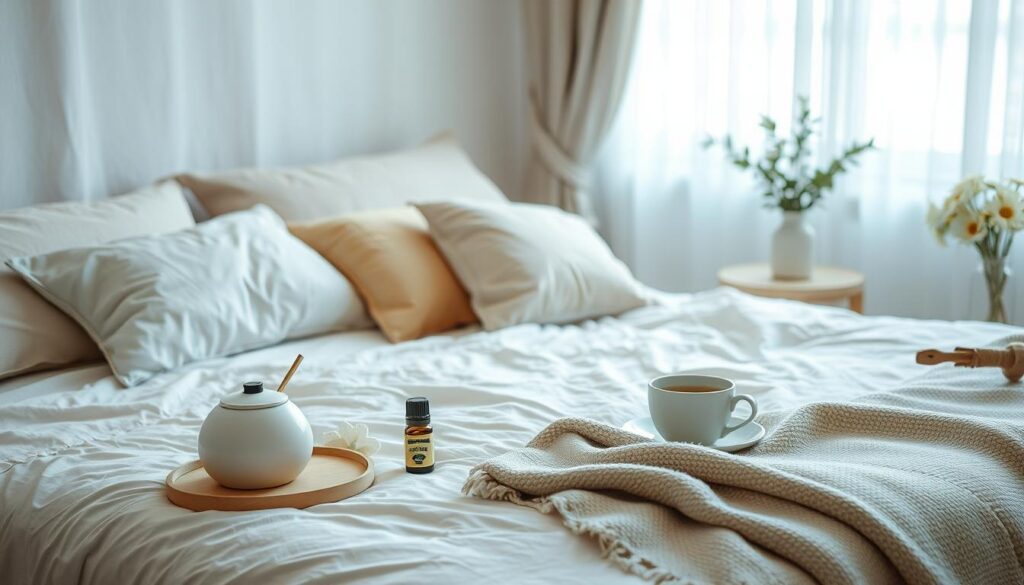
A serene bedroom setting featuring a cozy bed with soft, natural bedding. Surrounding the bed, include various natural sleep aids like herbal pillows, a small essential oil diffuser with calming oils, a neatly placed chamomile tea cup, and a cozy blanket draped over the side. Soft light filters through sheer curtains, creating a tranquil ambiance that emphasizes relaxation and comfort suitable for IT band pain relief.
|
Natural Sleep Aid |
Benefits |
Considerations |
|
Melatonin |
Helps regulate sleep-wake cycles. |
Consult with a healthcare professional for dosage. |
|
Valerian Root |
Promotes relaxation and reduces anxiety. |
May cause dizziness in some users. |
|
Chamomile |
Calming effects and aids digestion. |
May cause allergic reactions in some individuals. |
Maintaining Healthy Sleeping Habits
Good sleeping habits are key for feeling well and recovering from pain like IT band pain. By following certain practices, you can sleep better. This helps your body heal and feel refreshed.
Establishing a Consistent Sleep Schedule
Keeping a regular sleep schedule is important. It helps your body get into a rhythm. Going to bed and waking up at the same time every day is good for you.
This routine improves your sleep and makes you feel more alert and happy during the day.
Limiting Screen Time Before Bed
Too much screen time before bed can hurt your sleep. Devices give off blue light, which stops your body from making melatonin. Melatonin is what helps you fall asleep.
Try to avoid screens for a while before bed. This helps your mind relax and sleep better. It also helps your muscles recover from pain.

Understanding IT band pain is key to managing it well. Finding the best sleeping position and using relief techniques can help a lot. Paying attention to your sleep environment and routines also helps.
Using the right pillow, keeping a regular sleep schedule, and trying new remedies is a good plan. This approach helps manage IT band pain better. It makes sleeping well and reducing pain easier, improving your life quality.
By focusing on the right sleeping positions and comfort, you can reduce pain. Take care of yourself by making choices that meet your needs. This will help your healing process.
FAQ
What is the best sleeping position for IT band pain?
Side sleeping is best for IT band pain. It keeps the spine aligned and reduces pressure. Adding pillows for support can make it even more comfortable.
Can sleeping on my back help relieve IT band pain?
Yes, back sleeping can be good for IT band pain. Use pillows under your knees to keep your spine straight and lessen IT band strain.
Why should I avoid sleeping on my stomach if I have IT band pain?
Avoid stomach sleeping to prevent more pain. It puts too much stress on your spine and can make pain worse. This position also makes it hard to find relief.
Are there specific techniques to help reduce IT band pain during sleep?
Yes, using pillows and stretching before bed can help. These methods relax your muscles and reduce IT band tightness.
What kind of sleep environment is best for managing IT band pain?
For a good sleep environment, choose the right mattress and pillow. Keep the room quiet, cool, and dark. These factors improve your sleep quality.
Do natural sleep aids help with IT band pain relief?
Natural sleep aids like melatonin or valerian root can help sleep quality. This may indirectly help with IT band pain. Always talk to a doctor before trying them.
How can I establish healthy sleeping habits to help with IT band pain?
To sleep better, keep a regular sleep schedule and avoid screens before bed. These habits help your body recover from muscle pain, including IT band issues.

